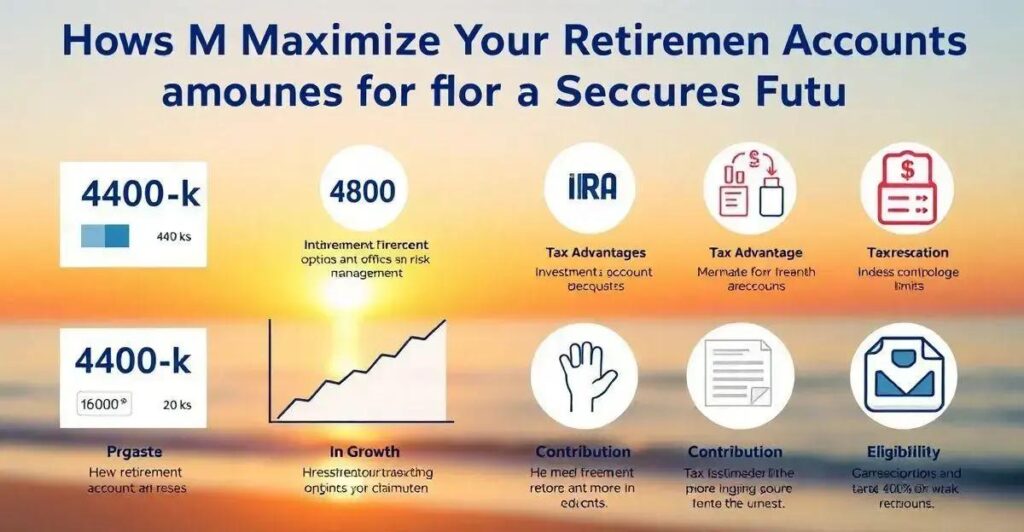Are you prepared for a secure retirement? It’s never too early to start planning and maximizing your savings.
With the right retirement accounts, you can ensure a comfortable lifestyle in your golden years.
In this article, we’ll explore the different types of retirement accounts, their contribution limits, eligibility, and benefits.
We’ll also discuss investment options, tax advantages, and withdrawal rules to help you make informed decisions.
Whether you’re just starting your career or nearing retirement, understanding retirement accounts is crucial to achieving your financial goals.
Types of Retirement Accounts: Choosing the Right One for You
When it comes to retirement accounts, the options can be overwhelming. There are traditional Individual Retirement Accounts (IRAs), Roth IRAs, 401(k)s, and even annuities. Each has its own set of rules, benefits, and limitations. As you navigate the world of retirement accounts, it’s essential to understand the differences between them.
IRAs are self-directed, allowing you to invest in a variety of assets, while Roth IRAs require you to pay taxes upfront in exchange for tax-free withdrawals. 401(k)s are employer-sponsored, offering a range of investment options and potential employer matching. Annuities, on the other hand, provide a steady income stream in retirement.
By understanding the characteristics of each type of retirement account, you can make an informed decision about which one is right for you.
Contribution Limits and Eligibility

When it comes to contributing to a retirement account, it’s essential to understand the contribution limits and eligibility requirements.
The annual contribution limit for traditional IRAs is $6,000, while the limit for Roth IRAs is $6,000 for individuals under 50 and $7,000 for those 50 and older.
401(k)s have a higher contribution limit, at $19,500, with an additional $6,500 catch-up contribution for those 50 and older.
Eligibility rules vary depending on the type of retirement account.
IRAs are available to anyone with earned income, while 401(k)s are typically offered by employers.
Annuities, on the other hand, may have more restrictive eligibility requirements.
Understanding the contribution limits and eligibility rules for each type of retirement account will help you make informed decisions about your retirement savings.
Investment Options and Risk Management
Investing in a retirement account requires a solid understanding of the options available and the risks involved.
Stocks, bonds, and mutual funds are popular investment options, each with its own unique characteristics.
Stocks offer the potential for high returns, but also come with higher risk.
Bonds, on the other hand, provide a steady income stream, but may not keep pace with inflation.
Mutual funds offer diversification, spreading risk across a range of assets.
Risk Management
Strategies include asset allocation, dollar-cost averaging, and diversification.
By understanding the investment options and risk management strategies available, you can make informed decisions about your retirement account and achieve your long-term goals.
Tax Advantages and Benefits

Tax-advantaged retirement accounts, such as 401(k)s and IRAs, offer a range of benefits, including tax-deferred growth and potential tax-free withdrawals.
Contributions to these accounts may be tax-deductible, reducing your taxable income.
In addition, earnings on these accounts grow tax-deferred, allowing your savings to compound over time.
Tax-Free Withdrawals
in retirement can provide a significant source of income, as you’ll only pay taxes on withdrawals in retirement.
By taking advantage of these tax benefits, you can maximize your retirement savings and achieve your long-term financial goals.
Retirement Account Withdrawal Rules and Penalties
When it’s time to withdraw from your retirement account, it’s essential to understand the rules and penalties associated with each type of account.
IRAs have a 10% penalty for withdrawals before age 59 1/2, unless you qualify for an exception.
401(k)s, on the other hand, have a 10% penalty for withdrawals before age 55, unless you retire or experience a qualifying event.
Required Minimum Distributions (RMDs)
must be taken from most retirement accounts starting at age 72, or by April 1 of the year after you turn 72.
Failure to take RMDs can result in penalties and taxes.
By understanding the withdrawal rules and penalties for your retirement account, you can avoid costly mistakes and ensure a smooth transition into retirement.
Conclusion: Planning for a Secure Retirement

In conclusion, planning for a secure retirement requires careful consideration of the various types of retirement accounts available, as well as their contribution limits, investment options, tax advantages, and withdrawal rules.
By understanding these factors, you can make informed decisions about your retirement savings and ensure a comfortable retirement. It’s never too early to start planning, and with the right strategy, you can achieve your long-term financial goals.
Remember to review and adjust your plan regularly to ensure it remains aligned with your changing needs and goals. With careful planning and discipline, you can secure a comfortable retirement and enjoy the fruits of your labor for years to come.
FAQ – Frequently Asked Questions about Retirement Accounts
What are the different types of retirement accounts?
There are various types of retirement accounts, including traditional Individual Retirement Accounts (IRAs), Roth IRAs, 401(k)s, and annuities, each with its own set of rules and benefits.
How do I choose the right retirement account for me?
Consider your financial goals, risk tolerance, and retirement timeline to determine which type of retirement account is best for you.
What are the contribution limits for retirement accounts?
The annual contribution limits for traditional IRAs and 401(k)s are $6,000, while Roth IRAs have a limit of $6,000 for individuals under 50 and $7,000 for those 50 and older.
Can I withdraw from my retirement account before age 59 1/2?
Yes, you can withdraw from your retirement account before age 59 1/2, but you may be subject to penalties and taxes.
What are the tax advantages of retirement accounts?
Retirement accounts offer tax-deferred growth and potential tax-free withdrawals, reducing your taxable income and allowing your savings to compound over time.
How do I plan for a secure retirement?
Start by setting clear financial goals, contributing regularly to your retirement account, and reviewing and adjusting your plan regularly to ensure it remains aligned with your changing needs and goals.



